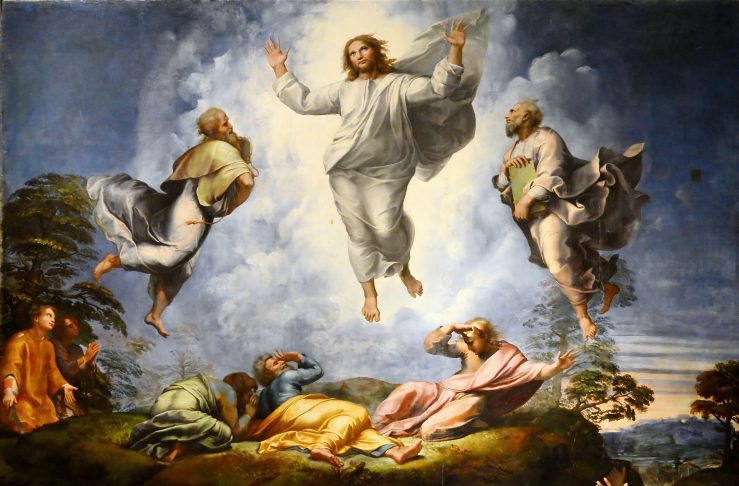
Lent – a time of prayer and mercy
II Sunday of Lent (Matthew 17:1-9)
The transfiguration of Jesus
 The difficulty of making visible the transformation of the human aspect of Jesus into his divine aspect is admirably overcome by Raphael Sanzio (1483/1520) in this masterpiece of 1518/20 painted a few days before his death, now in the Pinacoteca Vaticana: The Transfiguration. The author respects the hierarchy by placing in a natural landscape at the bottom the three apostles, who stunned take shelter from the strong and unfamiliar light, higher up from the ground are Elijah and Moses conversing and higher up the Redeemer, devoid of any real weight do
The difficulty of making visible the transformation of the human aspect of Jesus into his divine aspect is admirably overcome by Raphael Sanzio (1483/1520) in this masterpiece of 1518/20 painted a few days before his death, now in the Pinacoteca Vaticana: The Transfiguration. The author respects the hierarchy by placing in a natural landscape at the bottom the three apostles, who stunned take shelter from the strong and unfamiliar light, higher up from the ground are Elijah and Moses conversing and higher up the Redeemer, devoid of any real weight do
 minating the scene. Different sources of light and different colour effects are highlighted by the brightness of the cloud behind them from which God’s voice is heard. Everything takes place in silence: God’s voice, certainly sweet, proclaims the divinity of the Son. Only at the end of the transfiguration will the apostles have the strength to speak.
minating the scene. Different sources of light and different colour effects are highlighted by the brightness of the cloud behind them from which God’s voice is heard. Everything takes place in silence: God’s voice, certainly sweet, proclaims the divinity of the Son. Only at the end of the transfiguration will the apostles have the strength to speak.
 In contrast, in Antonio Ciseri’s Ecce Homo of 1871 in the Palazzo Pitti, all is commotion, disorder, shouting and outrageous gestures. In the Transfiguration he is exalted and glorified by God, in front of Pilate instead he is insulted and condemned by men. Here too the main characters are in the centre, but inside a palace on a terrace, with their backs to us. Soldiers and thugs await the sentence so that they can torture and prepare for the crucifixion of the condemned man. On the left, magistrates and scribes listen indifferently to Pilate’s speech. No emotion, no mercy or pity in their attitudes. In the transfiguration, the light is unifying and builds the figures with delicate colour gradients. In the condemnation all are in the shadows, only Pilate in the white mantle that envelops him is against the light as he points vigorously at Christ.
In contrast, in Antonio Ciseri’s Ecce Homo of 1871 in the Palazzo Pitti, all is commotion, disorder, shouting and outrageous gestures. In the Transfiguration he is exalted and glorified by God, in front of Pilate instead he is insulted and condemned by men. Here too the main characters are in the centre, but inside a palace on a terrace, with their backs to us. Soldiers and thugs await the sentence so that they can torture and prepare for the crucifixion of the condemned man. On the left, magistrates and scribes listen indifferently to Pilate’s speech. No emotion, no mercy or pity in their attitudes. In the transfiguration, the light is unifying and builds the figures with delicate colour gradients. In the condemnation all are in the shadows, only Pilate in the white mantle that envelops him is against the light as he points vigorously at Christ.
 The composure of the miraculous event, a sign of the mercy of God who shows his transfiguration so that the apostles may have the strength to preach, is contrasted by Pilate’s request for mercy who would like to save the innocent. In the transfiguration Jesus has a white robe that covers him entirely, in the condemnation he is partly covered by a red cloak while his uncovered torso shows the marks of torture. Christ’s face framed by wisps of fluttering hair has lost its bodily consistency and looks up to the sky, while before Pilate he has a dignified attitude, but his eyes are downcast and he does not look at the crowd; he already knows that Pilate’s speech will be useless: the numerous people thronging the street and the terraces have already made up their minds, shouting ‘crucify him’. Merciful God, merciless man.
The composure of the miraculous event, a sign of the mercy of God who shows his transfiguration so that the apostles may have the strength to preach, is contrasted by Pilate’s request for mercy who would like to save the innocent. In the transfiguration Jesus has a white robe that covers him entirely, in the condemnation he is partly covered by a red cloak while his uncovered torso shows the marks of torture. Christ’s face framed by wisps of fluttering hair has lost its bodily consistency and looks up to the sky, while before Pilate he has a dignified attitude, but his eyes are downcast and he does not look at the crowd; he already knows that Pilate’s speech will be useless: the numerous people thronging the street and the terraces have already made up their minds, shouting ‘crucify him’. Merciful God, merciless man.
Paola Carmen Salamino
Photo
- Paola Carmen Salamino
